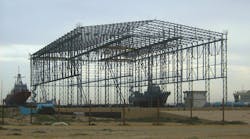As e-commerce continues to take the lion’s share of consumer purchases, warehouses are having to adapt. Not only does the distribution center have to be large, but they need to be adaptable to ensure both reliable and quick delivery.
This need has caused an increase in the construction of new, large warehouses that are also technologically very advanced.
An analysis of the market from Kim Kennedy, director of Forecasting for Dodge Data and Analytics found that construct starts for 2018, estimated at 283 million square feet ( msf) was a large jump from even 2017 which had 300 msf.
Looking at the size of the construction, Kennedy found the following:
During the past two years, however, those numbers have doubled. In 2017, an unprecedented 46 warehouse projects of one million square feet or more broke ground and in 2018 that figure increased to 48. The aggregate square footage of these large projects totaled 59.0 msf in 2017 and 64.1 msf in 2018. These massive warehouses accounted for a fifth of total square footage started in 2017 and a record 23% in 2018.
There are a variety of reasons for this increase, says Kennedy which include brick and mortar building onto their locations to serve the e-commerce market. But of course, Amazon is the major reason for the increase.
Kennedy reviews Amazon’s construction spree.
Amazon went on a construction spree in 2017, breaking ground on at least 44 warehouse projects that added a combined 26.4 msf of new space to the warehouse market. Of these, an estimated 11 projects (a combined 11.3 msf) were a million square feet or more. In 2018, Amazon continued to be a major player in warehouse development. Amazon started fewer, but larger projects: a total of 23 projects over the year for an additional 23.5 msf. Of these, the same number as in 2017 (11) were at least a million square feet, but the total square footage added by these projects was 17.8 msf. In fact, the four largest warehouse projects breaking ground in 2018 were all Amazon distribution centers that were more than 2 msf: a 2.68 msf Project Axis Distribution Center in Garner NC, a 2.6 msf Project Rose Fulfillment Center in Spokane WA, a 2.4 msf Project Dylan Fulfillment Center in Tulsa OK, and a 2.31 msf Fulfillment Center in Bessemer AL.
Walmart by comparison only had four warehouse projects in 2017, which in aggregate accounted for just 4.7 msf. Only two of the projects had more than a million square feet. The only five projects they did were altering existing buildings.
Looking at figures for January 2019 four warehouse projects with at least a million square feet of space broke ground, Kennedy says.
The Dodge planning database contains a dozen or more of these projects with strong potential to start in 2019. Among them are a 3.35 msf Amazon Air Hub in Hebron KY and three Walmart distribution centers (in Shafter CA at 1.75 msf, in Thomasville GA at 1.55 msf, and in Plainfield NY at 1.1 msf).
But Dodge doesn’t expect this expansion to continue. “While warehouse starts are likely to see modest declines this year as the construction market (and overall economy) round the cyclical peak, large projects will nevertheless remain a key part of the mix,” says Kennedy.



